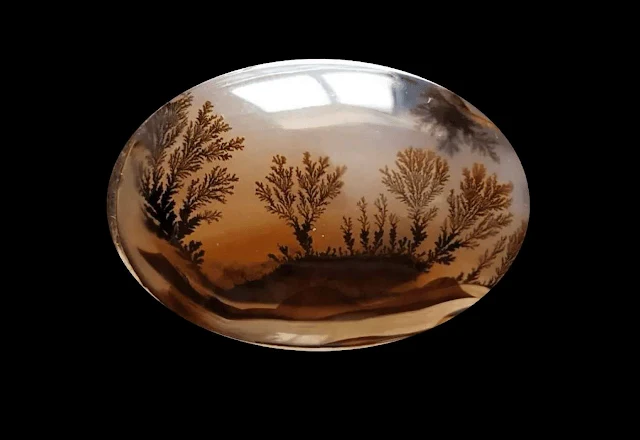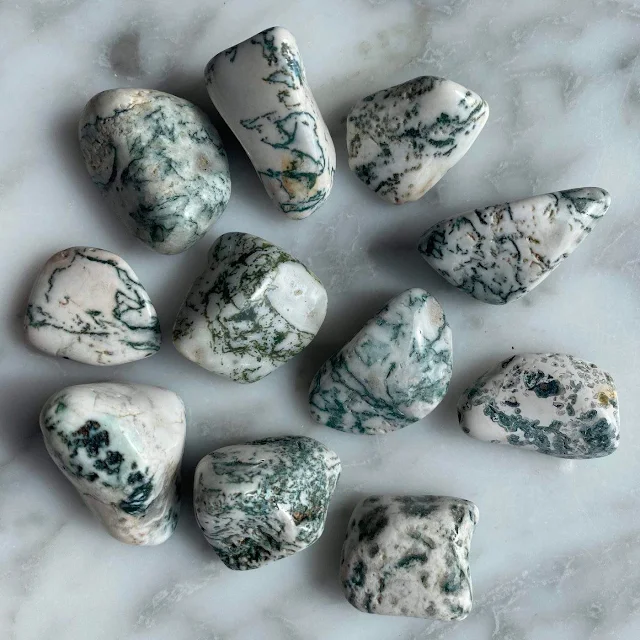Dendritic Agate: Composition, Properties and Uses
Dendritic agate is a stunning variety of agate chalcedony known for its mesmerizing inclusions that resemble tree branches, ferns, or veins of lightning. These dendritic formations, typically black or brown in color, are composed of manganese or iron oxide minerals that have crystallized within the milky white, gray, or light yellow-brown base of the stone.
While not technically an agate due to its lack of banding, dendritic agate is often grouped with its banded brethren due to its shared chalcedony composition and similar properties. It's found in various locations worldwide, including Brazil, India, Madagascar, Russia, and the United States.
The name "dendritic agate" comes from the Greek word "dendron," which means "tree."
Formation of Dendritic Agate
Dendritic agate belongs to the chalcedony family, a microcrystalline variety of quartz. It forms in cavities within volcanic rocks or sedimentary geodes, where silica-rich fluids slowly deposit layers of agate.
During this process, trace minerals like manganese and iron oxide get trapped within the agate, forming the dendritic patterns. These minerals crystallize in branching or fern-like shapes, mimicking the delicate veins of leaves or the intricate pathways of lightning.
 |
| Dendritic Agate |
The color of the dendrites ranges from black and brown to red and green, depending on the specific mineral composition. The base of the agate itself can be white, gray, yellow, or even a pale purple, creating a stunning contrast with the dendritic inclusions.
Composition of Dendritic Agate
Dendritic agate is primarily composed of silicon dioxide (SiO₂), the same mineral that makes up quartz.
The dendrites, however, are formed by various iron and manganese oxides, including iron(III) oxide (Fe₂O₃) and manganese dioxide (MnO₂).
These inclusions give dendritic agate its characteristic color variations, ranging from milky white with black dendrites to translucent grey with brown or red patterns.
 |
| Dendritic Agate gemstone |
Properties of Dendritic Agate
Color: Dendritic agate comes in a captivating range of colors, with a milky white base often adorned with black, brown, or red dendrites.
Luster: The stone possesses a waxy to greasy to vitreous luster, depending on the presence and distribution of impurities.
Streak: When scratched, dendritic agate leaves a white streak, reflecting its underlying chalcedony composition.
Hardness: This gemstone is relatively hard, with a rating of 6.5 to 7 on the Mohs scale. This makes it suitable for carving, polishing, and incorporating into jewelry.
Cleavage: Dendritic agate lacks a distinct cleavage, meaning it doesn't break along predictable planes. However, it can fracture conchoidally, exhibiting smooth, shell-like breakages.
Crystal Form: Dendritic agate doesn't have a well-defined crystal structure. It's a cryptocrystalline variety of quartz, meaning its crystals are too small to be seen individually under a microscope.
Solubility: Dendritic agate is insoluble in water and most common acids, making it a durable and long-lasting gemstone.
Magnetism: This stone is not magnetic, displaying no attraction or repulsion to magnets.
Fluorescence: Dendritic agate can exhibit weak fluorescence under longwave ultraviolet light, sometimes appearing with a faint yellow or green glow.
 |
| Tree agate |
Tree Agate
Tree agate is a specific type of dendritic agate, characterized by its white or milky base and green, fern-like dendrites. However, it's important to note that any dendritic agate with the appearance of tree branches or foliage could be considered a "tree agate."
Tree agate is often confused with moss agate, another variety of dendritic agate with a more moss-like pattern and sometimes more translucency.
- Moss agate: Can range from translucent to opaque, allowing light to pass through to varying degrees. Green inclusions usually arise from chlorite, actinolite, or epidote minerals within the chalcedony.
- Tree agate: Always completely opaque, with no light transmission. Green patterns typically come from manganese or iron oxide dendrites.
Dendritic Agate Uses
Dendritic agate's beauty goes beyond captivating visuals. This mesmerizing stone boasts a variety of uses, both practical and spiritual:
- Jewelry and Adornment: Its unique patterns and diverse colors make it stunning in rings, pendants, and more.
- Home Décor: Polished slabs, spheres, and tumbled stones add natural elegance to any space.
- Healing: The stone's calming energy tackles emotional turmoil, stress, and even physical ailments.
- Growth: Dendritic agate fosters connection to nature, sparks creativity, and attracts abundance in all aspects of life.
 |
| Rough Dendritic Agate |
Where is Dendritic Agate Found
Dendritic Agate, with its mesmerizing tree-like patterns, can be found in several locations around the globe, each offering its own unique variations in color and texture. Here are some of the key sources:
Brazil: The largest producer, known for its vibrant white, gray, and brown stones with intricate dendritic inclusions.
India: Renowned for its "Mocha stone" variety, featuring warm brown and gray tones with black dendritic patterns.
Madagascar: Offers a diverse range of colors, including white, gray, green, and even yellow, with intricate and delicate dendritic formations.
Mexico: A source of stunning light-colored stones, often with a milky or translucent appearance and delicate dendritic patterns.
United States: Primarily found in Oregon and Montana, with a variety of colors including white, gray, brown, and yellow, and bolder dendritic formations.
 |
| Dendritic Agate Cabochon |
 |
| Polished Dendritic Agate |
 |
| Dendritic Agate |
 |
| Rough dendrite agate |
Read also:
What Is Grape Agate
Crazy Lace Agate
Iris Agate - A Rainbow in Stone








